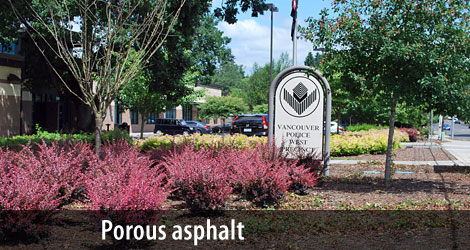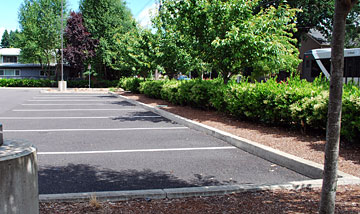Porous asphalt
Porous asphalt is a flexible pavement that uses a bituminous material to bind aggregate. Porous asphalt over an aggregate storage bed will reduce stormwater runoff volume, rate, and pollutants. The reduced fines leave stable air pockets in the asphalt. The interconnected void space allows stormwater to flow through the asphalt and enter a crushed stone aggregate bedding layer and base that supports the asphalt while providing storage and runoff treatment. Porous asphalt tends to perform well in pedestrian walkways, sidewalks, driveways, parking lots, and low-volume roadways. Porous asphalt could be designed and sited to intercept, contain, filter, and infiltrate stormwater on site.
FEATURED SITE - Vancouver Police West Precinct
2800 Stapleton Rd., Vancouver
The LEED Silver-certified building was remodeled and opened in 2009.
Permeable asphalt – Stormwater from the three-acre site is treated and infiltrated by 46,838-square-feet of porous asphalt, a bioswale and drywell. Both the porous asphalt and pipe infiltrating roof runoff are designed to handle rain from a 100-year storm. The site can infiltrate stormwater at a rate of 31.5 inches per hour. The catchment size is 34 feet by 16 feet by 85.4 feet. The chamber storage is 14.7 cubic feet.
Native plantings – Multiple landscape beds use native and drought-tolerant plants, reducing irrigation water by 70 percent and saving more than 2,000 gallons of water per year. A drip irrigation system minimizes watering.
LID Techniques

